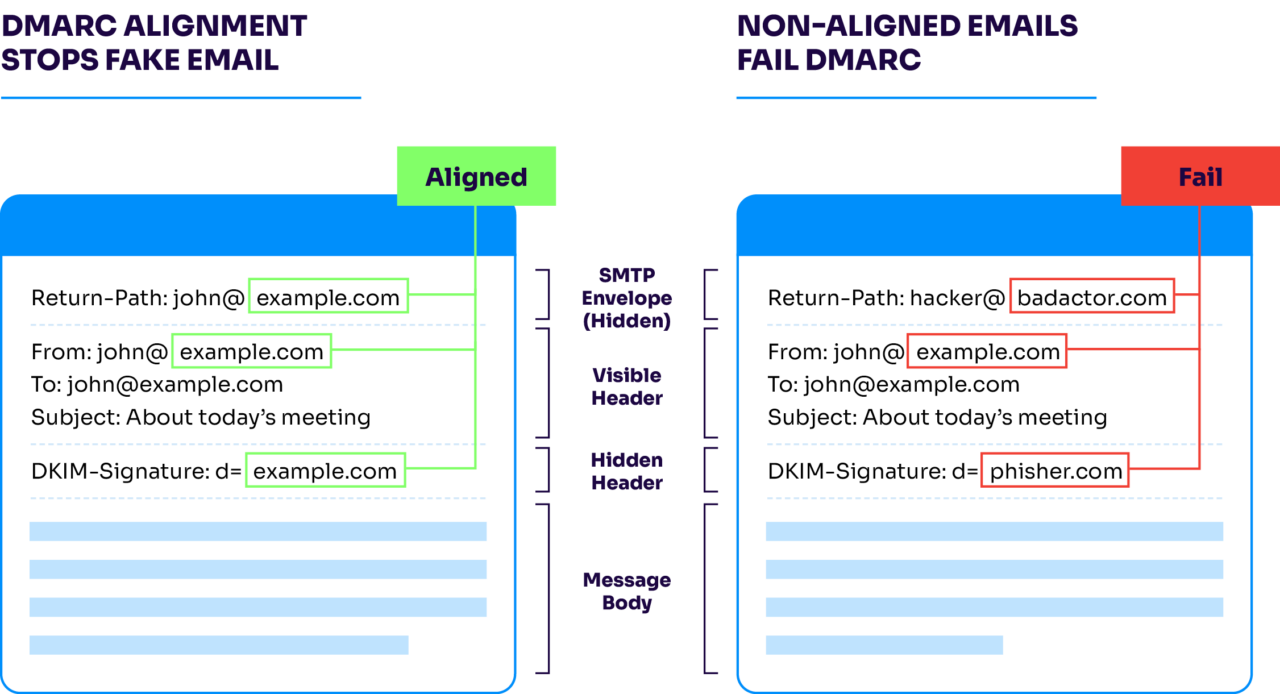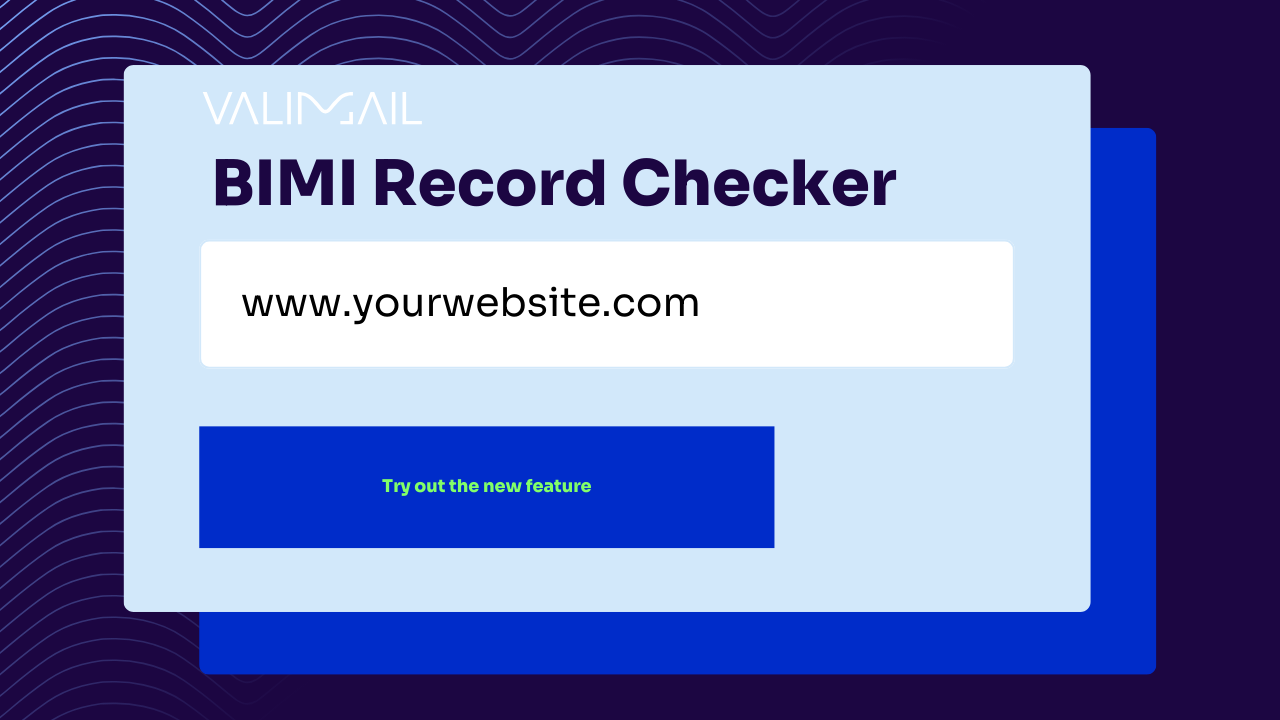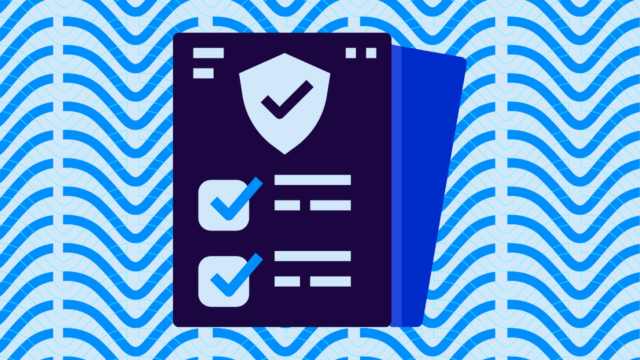See if your brand is ready for inbox logos in just a few clicks.
Check your
domain now
Enter your domain to see if it’s vulnerable to spoofing or if others are sending emails on your behalf. Instantly check your DMARC, SPF, and BIMI status with a detailed security report.
You’re not fully protected, learn more here.
Check your
domain now
Enter your domain to see if it’s vulnerable to spoofing or if others are sending emails on your behalf. Instantly check your DMARC, SPF, and BIMI status with a detailed security report.
You’re not fully protected, learn more here.
Check your
domain now
Enter your domain to see if it’s vulnerable to spoofing or if others are sending emails on your behalf. Instantly check your DMARC, SPF, and BIMI status with a detailed security report.
You’re not fully protected, learn more here.
Your Domain
Not protected AGAINST IMPERSONATION ATTACKS
DMARC NOT AT ENFORCEMENT
exampledomain1.com
Authentication Status for January 10, 2025
DMARC at Enforcement
SPF Record Configured
BIMI Ready
exampledomain1.com
Authentication Status for January 10, 2025
DMARC at Enforcement
SPF Record Configured
BIMI Ready
Ready for your brand’s logo to show up next to your emails in people’s inboxes? BIMI makes it happen, and it’s not just for the enterprise companies anymore. With the right tools and know-how, any legitimate business can get its logo in the inbox.
BIMI (Brand Indicators for Message Identification) sounds like another boring email acronym, but it’s actually pretty cool. It lets your official logo show up in supporting email clients like Gmail and Yahoo to make your messages instantly recognizable.
The catch? Well, your email authentication has to be absolutely spot-on first.
That’s where our BIMI checker comes in. Instead of digging through DNS records and deciphering technical specifications, this tool tells you in seconds if you’re BIMI-ready or what’s standing in your way. No technical jargon, no complicated reports—just clear answers about whether your brand can show up in the inbox.
Below, we’ll show you exactly how to use our BIMI checker, what the results actually mean, and step-by-step instructions for fixing the most common roadblocks.
Why BIMI is a big deal for your brand
Email isn’t exactly the most exciting marketing channel. However, BIMI changes that by turning your everyday messages into mini-billboards for your brand.
BIMI essentially lets your logo appear right next to your emails in the recipient’s inbox. Imagine every message you send carrying your visual brand identity before it’s even opened. It’s like getting a free brand impression with every email you send…and your customers don’t even have to open it.
Who’s supporting BIMI now?
Gmail and Yahoo Mail (two of the biggest email providers) now display BIMI logos. When you consider that Gmail alone has over 1.8 billion users, that’s a massive audience seeing your brand. Apple Mail has started supporting BIMI too, and others are expected to follow.

Think about how many of your emails get opened on these platforms daily. Each one could be a branded touchpoint rather than just another text entry in a crowded inbox.
It’s not just vanity metrics
BIMI isn’t just a cosmetic upgrade. Research shows that emails with brand logos displayed are opened 18-21% more often than those without. People trust what they recognize, and your logo creates that instant recognition.
Email inboxes are noisy places. The average person gets dozens of emails daily, and they make split-second decisions about what’s worth their attention. Your logo gives recipients a visual shortcut to identify legitimate messages from your company.
Beyond the marketing benefits, BIMI helps protect your customers from scams. When someone tries to impersonate your company (a common phishing tactic), their fake emails won’t display your logo. And that makes the imposters easier to spot. Recipients learn to look for your logo as confirmation they’re dealing with the real you.
The not-so-fun bit: technical requirements
Here’s where things get a bit complicated. Before you can implement BIMI, you need:
- DMARC enforcement (p=quarantine or p=reject)
- SPF and DKIM properly configured
- A correctly formatted SVG logo file
- A BIMI DNS record
- Potentially a Verified Mark Certificate (VMC) or a Common Mark Certificate (CMC) for Gmail
Learning how to set up BIMI might sound like a technical nightmare, but getting it right means better brand recognition, increased open rates, and stronger protection against email fraud. Pretty good payoff for the effort, right?
What our BIMI checker actually tells you
When you run a domain through our BIMI checker, you get more than just a technical readout or confusing jargon. Our tool gives you a clear picture of whether your brand is ready for inbox logos (and exactly what’s standing in your way if you’re not).
BIMI check
The first thing you’ll see is a straightforward status indicator showing if your domain is “BIMI Ready” or “Not BIMI Ready.” This cuts through all the technical details and tells you what you really want to know: can your logo appear in recipients’ inboxes or not?
If you’re BIMI ready, you’ll see a confirmation that your logo can start appearing in supporting email clients like Gmail and Yahoo Mail. If you’re not ready, the checker clearly identifies what’s missing.

Authentication foundation check
Since BIMI requires strong email authentication as its foundation, our checker first verifies your DMARC status:
- DMARC at enforcement: This is what you need to see. It means your domain has a DMARC policy set to either quarantine or reject suspicious emails—a requirement for BIMI.
- DMARC not at enforcement: This warning appears when either you have no DMARC record at all or your policy is set to p=none, which only monitors without taking action. BIMI won’t work without DMARC enforcement, so this needs fixing first.
The tool displays your actual DMARC record so you can see exactly what’s configured:
v=DMARC1; p=reject; sp=reject; pct=100; adkim=r; aspf=r; rua=mailto:dmarc_agg@example.com; …SPF and DKIM verification
The checker also examines your SPF and DKIM setup, which are building blocks for DMARC enforcement:
- SPF Record Configured: This means your SPF record exists and meets best practices.
- SPF Record Misconfigured: This indicates problems with your SPF record that could prevent BIMI from working properly, such as too many lookups or overly permissive settings.
For complete transparency, we show you the actual SPF record we found:
v=spf1 include:example.com._nspf.vali.email include:%{i}._ip.%{h}._ehlo.%{d}._spf.vali.email ~allReport sharing and download
Once you’ve reviewed your results, you can download a PDF report or email it to yourself (or your marketing team) for later reference. These reports are perfect for sharing with stakeholders or tracking your progress toward BIMI readiness.
How to use the BIMI record checker
Using our BIMI checker is simple, but knowing what to do with the results takes a bit more know-how. Here’s how to get the most from the tool:
1. Run your first BIMI check
To get started:
- Enter your domain name in the search box (just the domain, like “yourbrand.com”—no need for http:// or www)
- Click the “Check domain” button
- Wait a few seconds while our tool queries DNS records and analyzes the results
That’s it for the basics. The tool works instantly, pulling live data to give you the most up-to-date picture of your BIMI readiness.
2. Understand your results
Once the check is complete, take a moment to understand what you’re looking at:
- If you see “BIMI Ready” – Great! Your domain has everything needed for your logo to display in supporting email clients. You might still want to check the details to guarantee your logo file is optimized.
- If you see “Not BIMI Ready” – Your domain is missing one or more requirements for BIMI. Look at the specific criteria that failed to understand what needs fixing first.
Pay special attention to the authentication status. Since DMARC at enforcement is a prerequisite for BIMI, you’ll need to fix this before anything else if it’s showing as “not at enforcement.”
3. Check these components
- Review your current DMARC record (if you have one): The tool displays your actual record exactly as it appears in DNS. For BIMI to work, you need to have p=quarantine or p=reject policy with at least a 100% enforcement rate.
- Look at your SPF and DKIM status: Even with DMARC in place, misconfigured SPF or DKIM can undermine your authentication and prevent BIMI from working.
- Verify your BIMI record: If you already have one, check for syntax errors or missing elements. If you don’t have one yet, you’ll need to create one using the format shown in our recommendations.
- Check your logo file: BIMI requires a specific SVG format (SVG Tiny 1.2), and our checker will tell you if your file meets these requirements.
4. Take action based on priority
Depending on what you find, here’s what to do next:
If you have no DMARC or it’s set to p=none: This is job #1. You’ll need to implement DMARC at enforcement before BIMI can work. Start by setting up DMARC reporting and gradually move to enforcement.
If your authentication is solid but you need a BIMI record: Create one using this format:
v=BIMI1; l=https://yourdomain.com/logo.svg; a=https://yourdomain.com/vmc.pem;5. Tips for getting the most from the checker
- Check multiple domains: If your organization uses several domains for sending email, run the check on each one. BIMI needs to be configured separately for each domain.
- Test after making changes: DNS changes typically take 24-48 hours to fully propagate. Run the checker again after this period to confirm your changes were successful.
- Save your results: Use the “Download Report as PDF” option to keep a record of your current status. This is useful for tracking progress or sharing with your team.
- Schedule regular checks: Email configurations change over time, and it’s easy for BIMI requirements to break without notice. Make it a habit to check your status monthly.
Most common BIMI roadblocks (and how to fix them)
Even tech-savvy teams run into obstacles when implementing BIMI. Here are the problems we see most often and simple(ish) ways to fix them:
Missing or weak DMARC enforcement
What it means: Your domain either has no DMARC record or it’s set to monitoring mode (p=none). BIMI absolutely requires DMARC at enforcement, meaning p=quarantine or p=reject at 100%.
How to fix it:
- If you have no DMARC, start with a basic monitoring policy:
v=DMARC1; p=none; rua=mailto:dmarc-reports@yourdomain.com- After monitoring for 2-4 weeks to guarantee legitimate email isn’t failing:
- Move to p=quarantine; pct=100
- Finally, move to p=reject; pct=100
- Create this as a TXT record with the host/name “_dmarc” in your DNS settings
Don’t rush this process. Moving to enforcement too quickly can block legitimate email. BIMI is worth the wait to get DMARC right first.
No BIMI record found
What it means: You’ve got DMARC at enforcement, but haven’t created the actual BIMI record yet.
How to fix it:
- Log in to your DNS provider
- Create a new TXT record with the host/name “_bimi”
- Set the value to this basic format:
v=BIMI1; l=https://yourdomain.com/logo.svg; - If you have a VMC certificate for Gmail, add the a= tag:
v=BIMI1; l=https://yourdomain.com/logo.svg; a=https://yourdomain.com/vmc.pem;
The “l=” tag points to your logo file location, while the optional “a=” tag points to your VMC certificate.
SPF or DKIM alignment issues
What it means: Your SPF or DKIM isn’t properly aligned with your From domain, causing DMARC to fail, which prevents BIMI from working.
How to fix it:
- Check your DMARC record for alignment settings:
- “adkim=r” means relaxed DKIM alignment (subdomains match)
- “aspf=r” means relaxed SPF alignment (subdomains match)
- Double-check your sending services authenticate correctly:
- SPF should authorize all servers sending from your domain
- DKIM should be properly set up with each email service you use
- The domain in your “From” header should match (or be a subdomain of) your authenticated domain

Alignment issues can be tricky to find. If you’re stuck, our DMARC monitoring service (it’s free) can help identify exactly what’s causing the problem.
Your BIMI implementation checklist
Here’s a step-by-step checklist to make it happen. Bookmark this page—you’ll want to return as you work through each stage of your BIMI implementation.
1. Get DMARC to enforcement first
Check your current DMARC status using our checker tool
Set up DMARC reporting if you haven’t already
Monitor reports for at least 2-4 weeks to identify legitimate senders
Fix any authentication issues discovered in reports
Move to p=quarantine with 100% enforcement (pct=100)
Monitor for delivery issues for another 1-2 weeks
Move to p=reject with 100% enforcement
Verify DMARC is working properly before moving to the next step
2. Prepare your logo file
Create an SVG version of your logo (if you don’t have one already)
Convert to SVG Tiny 1.2 format
Make it square (1:1 aspect ratio)
Simplify the design for small-size visibility
Remove any external references or JavaScript
Validate your SVG with a BIMI SVG validator
Host the file on a secure server (HTTPS required)
3. Decide on VMC certification
Research if your audience uses Gmail significantly
Verify you have a registered trademark for your logo
Choose a VMC or CMC provider (DigiCert, Entrust, or Mark Monitor)
Budget for the certification cost ($1,000+ annually)
Gather trademark documentation
Submit application to your chosen provider
Complete verification process
Receive and host your certificate on a secure server
A VMC or CMC is required for Gmail display but optional for Yahoo Mail and other providers. If Gmail users make up a major portion of your audience, this step is worth the investment.
4. Create and publish your BIMI record
Log in to your DNS provider
Create a new TXT record with host/name “_bimi”
Add your basic BIMI record
Include VMC if you have one
Save changes and wait for DNS propagation (24-48 hours)
5. Test and monitor your BIMI display
Run our BIMI checker again after DNS propagation
Send test emails to accounts on supporting providers (Gmail, Yahoo)
Check if your logo appears in recipients’ inboxes
Take screenshots of successful displays for your records
Set up regular monitoring to guarantee continued compliance
Schedule quarterly checks of your BIMI setup
Need help with any of these steps? Our automated BIMI implementation service can handle the technical work while you focus on creating email campaigns that’ll now stand out with your logo.
Get your brand in the inbox…without the headaches
We get it. Implementing BIMI sounds great in theory, but the reality involves juggling DMARC enforcement, SVG file formatting, and possibly VMC certification. That’s a lot of technical hoops to jump through just to get your logo showing up.
Fortunately, we can help.
Valimail Amplify automates the entire BIMI implementation process:
- Fast-track your BIMI setup if you’re already at DMARC enforcement
- Manage multiple brand logos across different domains with a single click
- Streamline VMC/CMC certificate acquisition and management
- See immediate results with our BIMI Simulator before you commit
While our free checker helps identify what’s missing, Amplify handles the technical work for you. Why wrestle with DNS records and SVG specifications when you could be focusing on creating emails that engage your audience?
Ready to get started? Run your domain through the BIMI checker, and let’s see what you need.



